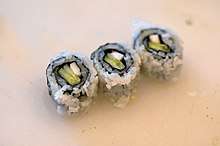California roll
 Home-made California rolls | |
| Alternative names | カリフォルニアロール (kariforunia rōru) |
|---|---|
| Course | Main course |
| Place of origin | United States |
| Region or state | California |
| Main ingredients | Rice, cucumber, crab meat or imitation crab, and avocado |
| 1 serving (2 pieces), 129[1] kcal | |
A California roll or California maki is a makizushi sushi roll, usually made inside-out, containing cucumber, crab meat or imitation crab, and avocado. Sometimes crab salad is substituted for the crab stick, and often the outer layer of rice in an inside-out roll (uramaki) is sprinkled with toasted sesame seeds, tobiko or masago (capelin roe).
As one of the most popular styles of sushi in the United States and Canada, the California roll has been influential in sushi's global popularity and in inspiring sushi chefs around the world in creating their non-traditional fusion cuisine.[2]
History
The identity of the creator of the California roll is disputed, with chefs from both Los Angeles and Vancouver claiming credit.
The earliest documented claim for the invention of the California roll credits a Los Angeles chef named Ken Seusa at the Kin Jo sushi restaurant near Hollywood. The claim was made by Mrs. Fuji Wade, manager of the restaurant, and reported in an Associated Press news feed in 1979. Food writer Andrew F. Smith observes that this claim stood uncontested for more than 20 years.[3][4]
The AP story appeared very shortly after the term "California roll" was used in print, in the Los Angeles Times and an Ocala, Florida newspaper on November 25, 1979.[3] The California roll was featured by Gourmet magazine in 1980, and taken up by a restaurant critic for The New York Times the following year.[5]
A rival theory attributes the invention to Ichiro Mashita, another Los Angeles sushi chef, from the Tokyo Kaikan in Little Tokyo.[6] According to this account, Mashita began substituting avocado for toro (fatty tuna) in the off-season, and after further experimentation, developed the prototype, back in the 1960s[7][8][9] (or early 1970s[10]).
Another rival theory is that the California roll was created in Canada by chef Hidekazu Tojo, a Japanese-born resident of Vancouver since 1971.[11] Tojo insists he is the innovator of the "inside-out" sushi, and it got the name "California roll" because it was popular with patrons from Los Angeles.[11][12] He has recounted how his original invention included cucumber, cooked crab, and avocado.[13]
Early California roll recipes used frozen king crab legs, since surimi imitation crab was not yet available.[14] Cucumber, mayonnaise, and sesame seed were missing; these ingredients were all added later.[6] The original California roll was wrapped traditional style, with the nori seaweed on the outside, which American customers tended to peel off. So eventually the roll "inside-out", i.e. uramaki version was developed.[15] This adaptation has also been credited to Mashita by figures associated with the restaurant.[lower-alpha 1][10]
After becoming a favorite in Southern California, the dish became popular all across the United States by the 1980s. The roll contributed to sushi's growing popularity in the United States by easing diners into more exotic sushi options.[16] Sushi chefs have since devised many kinds of rolls, beyond simple variations of the California roll.
Notes
- ↑ In Issenberg 2007 and other references, the chief eyewitness source for the California roll story is Noritoshi Kanai of Mutual Trading, an importer that was the supplier to the restaurant. In the San Diego Union piece, it is his daughter Atsuko Kanai, vice president of Mutual Trading, who credits Mashita with making the roll "inside-out".
References
- Citations
- ↑ "Nutrition, Carbohydrate and Calorie Counter". Calories in California Sushi Rolls. Retrieved May 31, 2016.
- ↑ Renton, Alex (February 26, 2006). "How Sushi ate the World". The Guardian. Retrieved August 20, 2006.
- 1 2 Smith, Andrew F. (2012). 'American Tuna: The Rise and Fall of an Improbable Food. University of California Press. p. 91. and notes 31 and 32
- ↑ "Raw Fish is the Rage around Los Angeles". The News Journal. Associated Press. December 19, 1979. p. 68.
- ↑ Smith (2013), '3, p. 885.
- 1 2 Dwyer, Lexi. "Deconstructing the California Roll". Gourmet. , citing author Trevor Corson himself, rather than his book, Corson 2008.
- ↑ Issenberg (2007), pp. 89–91.
- ↑ Corson (2008), p. 82.
- ↑ McInerney, Jay (June 10, 2007). "Raw". The New York Times. Retrieved August 15, 2008. (book review of Corson 2007 and Issenberg 2007)
- 1 2 Hunt, Maria (August 24, 2005). "East-West Fusion: nontraditional ingredients give sushi local flavor". San Diego Union-Tribune. Archived from the original on March 5, 2016. Retrieved August 20, 2006.
- 1 2 White, Madeleine (October 23, 2012). "Meet the man behind the California roll". The Globe and Mail.
- ↑ "Japan to honour Vancouver chef credited with inventing California roll". CTV News. Relaxnews. June 15, 2016. Retrieved October 17, 2013.
- ↑ Great Big Story (April 24, 2017), The California Roll Was Invented in Canada, retrieved June 20, 2017
- ↑ Issenberg (2007), p. 91.
- ↑ Issenberg (2007), pp. 90–91.
- ↑ Kestler, John (June 18, 2006). "The Sushification of America". The Atlanta Journal-Constitution.
- Bibliography
- Corson, Trevor (2007). The Zen of Fish: The Story of Sushi, from Samurai to Supermarket. HarperCollins. ISBN 978-0060883508.
- Corson, Trevor (2008). The Story of Sushi: An Unlikely Saga of Raw Fish and Rice. Harper Perennial. ISBN 978-0060883515.
- Issenberg, Sasha (2007). The Sushi Economy: Globalization and the Making of a Modern Delicacy. Penguin. ISBN 9781592402946.
- Smith, Andrew F. (2013). "Sushi and sashimi". Food and Drink in American History: A "Full Course" Encyclopedia. 3. ABC-CLIO. ISBN 9781610692335.
External links
![]()